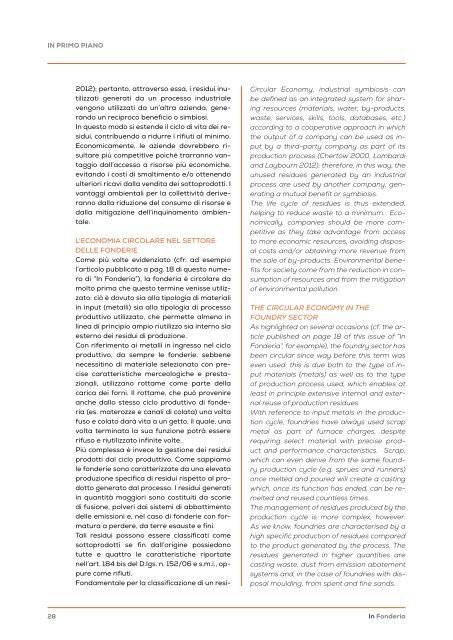In Fonderia 2 2024
Secondo numero del 2024 di In Fonderia
Secondo numero del 2024 di In Fonderia
Create successful ePaper yourself
Turn your PDF publications into a flip-book with our unique Google optimized e-Paper software.
IN PRIMO PIANO<br />
2012); pertanto, attraverso essa, i residui inutilizzati<br />
generati da un processo industriale<br />
vengono utilizzati da un’altra azienda, generando<br />
un reciproco beneficio o simbiosi.<br />
<strong>In</strong> questo modo si estende il ciclo di vita dei residui,<br />
contribuendo a ridurre i rifiuti al minimo.<br />
Economicamente, le aziende dovrebbero risultare<br />
più competitive poiché trarranno vantaggio<br />
dall’accesso a risorse più economiche,<br />
evitando i costi di smaltimento e/o ottenendo<br />
ulteriori ricavi dalla vendita dei sottoprodotti. I<br />
vantaggi ambientali per la collettività deriveranno<br />
dalla riduzione del consumo di risorse e<br />
dalla mitigazione dell’inquinamento ambientale.<br />
L’ECONOMIA CIRCOLARE NEL SETTORE<br />
DELLE FONDERIE<br />
Come più volte evidenziato (cfr. ad esempio<br />
l’articolo pubblicato a pag. 18 di questo numero<br />
di “<strong>In</strong> <strong>Fonderia</strong>”), la fonderia è circolare da<br />
molto prima che questo termine venisse utilizzato:<br />
ciò è dovuto sia alla tipologia di materiali<br />
in input (metalli) sia alla tipologia di processo<br />
produttivo utilizzato, che permette almeno in<br />
linea di principio ampio riutilizzo sia interno sia<br />
esterno dei residui di produzione.<br />
Con riferimento ai metalli in ingresso nel ciclo<br />
produttivo, da sempre le fonderie, sebbene<br />
necessitino di materiale selezionato con precise<br />
caratteristiche merceologiche e prestazionali,<br />
utilizzano rottame come parte della<br />
carica dei forni. Il rottame, che può provenire<br />
anche dallo stesso ciclo produttivo di fonderia<br />
(es. materozze e canali di colata) una volta<br />
fuso e colato darà vita a un getto, il quale, una<br />
volta terminata la sua funzione potrà essere<br />
rifuso e riutilizzato infinite volte.<br />
Più complessa è invece la gestione dei residui<br />
prodotti dal ciclo produttivo. Come sappiamo<br />
le fonderie sono caratterizzate da una elevata<br />
produzione specifica di residui rispetto al prodotto<br />
generato dal processo. I residui generati<br />
in quantità maggiori sono costituiti da scorie<br />
di fusione, polveri dai sistemi di abbattimento<br />
delle emissioni e, nel caso di fonderie con formatura<br />
a perdere, da terre esauste e fini.<br />
Tali residui possono essere classificati come<br />
sottoprodotti se fin dall’origine possiedono<br />
tutte e quattro le caratteristiche riportate<br />
nell’art. 184 bis del D.lgs. n. 152/06 e s.m.i., oppure<br />
come rifiuti.<br />
Fondamentale per la classificazione di un resi-<br />
Circular Economy, industrial symbiosis can<br />
be defined as an integrated system for sharing<br />
resources (materials, water, by-products,<br />
waste, services, skills, tools, databases, etc.)<br />
according to a cooperative approach in which<br />
the output of a company can be used as input<br />
by a third-party company as part of its<br />
production process (Chertow 2000, Lombardi<br />
and Laybourn 2012); therefore, in this way, the<br />
unused residues generated by an industrial<br />
process are used by another company, generating<br />
a mutual benefit or symbiosis.<br />
The life cycle of residues is thus extended,<br />
helping to reduce waste to a minimum. Economically,<br />
companies should be more competitive<br />
as they take advantage from access<br />
to more economic resources, avoiding disposal<br />
costs and/or obtaining more revenue from<br />
the sale of by-products. Environmental benefits<br />
for society come from the reduction in consumption<br />
of resources and from the mitigation<br />
of environmental pollution.<br />
THE CIRCULAR ECONOMY IN THE<br />
FOUNDRY SECTOR<br />
As highlighted on several occasions (cf. the article<br />
published on page 18 of this issue of “<strong>In</strong><br />
<strong>Fonderia</strong>”, for example), the foundry sector has<br />
been circular since way before this term was<br />
even used: this is due both to the type of input<br />
materials (metals) as well as to the type<br />
of production process used, which enables at<br />
least in principle extensive internal and external<br />
reuse of production residues.<br />
With reference to input metals in the production<br />
cycle, foundries have always used scrap<br />
metal as part of furnace charges, despite<br />
requiring select material with precise product<br />
and performance characteristics. Scrap,<br />
which can even derive from the same foundry<br />
production cycle (e.g. sprues and runners)<br />
once melted and poured will create a casting<br />
which, once its function has ended, can be remelted<br />
and reused countless times.<br />
The management of residues produced by the<br />
production cycle is more complex, however.<br />
As we know, foundries are characterised by a<br />
high specific production of residues compared<br />
to the product generated by the process. The<br />
residues generated in higher quantities are<br />
casting waste, dust from emission abatement<br />
systems and, in the case of foundries with disposal<br />
moulding, from spent and fine sands.<br />
28<br />
<strong>In</strong> <strong>Fonderia</strong>














